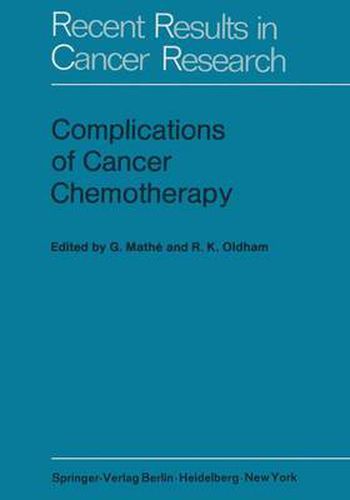Readings Newsletter
Become a Readings Member to make your shopping experience even easier.
Sign in or sign up for free!
You’re not far away from qualifying for FREE standard shipping within Australia
You’ve qualified for FREE standard shipping within Australia
The cart is loading…






This title is printed to order. This book may have been self-published. If so, we cannot guarantee the quality of the content. In the main most books will have gone through the editing process however some may not. We therefore suggest that you be aware of this before ordering this book. If in doubt check either the author or publisher’s details as we are unable to accept any returns unless they are faulty. Please contact us if you have any questions.
G. MATHE and R. K. OLDHAM’~ Institut de Cancerologie et d'Immunogem!tique, Hopital Paul Brousse, Villejuif Since the last war, cancer chemotherapy has been the object of very intensive and expensive research. Nevertheless, its development has been very slow, and its ultimate potential is today somewhat in doubt. In doubt because it does not cure any cancer patients except a) females carrying placental choriocarcinoma, a semi-allogenic tumor, in which case, cure may be in fluenced by immune rejection, and b) children suffering from Burkitt’s tumor, where the probable reason for the cure is that all the neoplastic cells are in the cycle, which is a unique condition among all the human tumor varieties. Whether the long term survivors in acute leukemia, lymphomas, certain sarcomas and certain testicular tumors are cures will require longer follow-up. The idea that chemotherapy does not cure most cancer patients because all their neoplastic cells are not in cycle has led to the use of drug combinations. Whatever they are, cocktail combinations which are made up of drugs given according to any timing, or scientific combinations, based on pharmacodynamics, pharmaco kinetics or cell kinetics data, are more toxic than single drugs, and are all the more toxic as the number of drugs in the combination is increased.
$9.00 standard shipping within Australia
FREE standard shipping within Australia for orders over $100.00
Express & International shipping calculated at checkout
This title is printed to order. This book may have been self-published. If so, we cannot guarantee the quality of the content. In the main most books will have gone through the editing process however some may not. We therefore suggest that you be aware of this before ordering this book. If in doubt check either the author or publisher’s details as we are unable to accept any returns unless they are faulty. Please contact us if you have any questions.
G. MATHE and R. K. OLDHAM’~ Institut de Cancerologie et d'Immunogem!tique, Hopital Paul Brousse, Villejuif Since the last war, cancer chemotherapy has been the object of very intensive and expensive research. Nevertheless, its development has been very slow, and its ultimate potential is today somewhat in doubt. In doubt because it does not cure any cancer patients except a) females carrying placental choriocarcinoma, a semi-allogenic tumor, in which case, cure may be in fluenced by immune rejection, and b) children suffering from Burkitt’s tumor, where the probable reason for the cure is that all the neoplastic cells are in the cycle, which is a unique condition among all the human tumor varieties. Whether the long term survivors in acute leukemia, lymphomas, certain sarcomas and certain testicular tumors are cures will require longer follow-up. The idea that chemotherapy does not cure most cancer patients because all their neoplastic cells are not in cycle has led to the use of drug combinations. Whatever they are, cocktail combinations which are made up of drugs given according to any timing, or scientific combinations, based on pharmacodynamics, pharmaco kinetics or cell kinetics data, are more toxic than single drugs, and are all the more toxic as the number of drugs in the combination is increased.